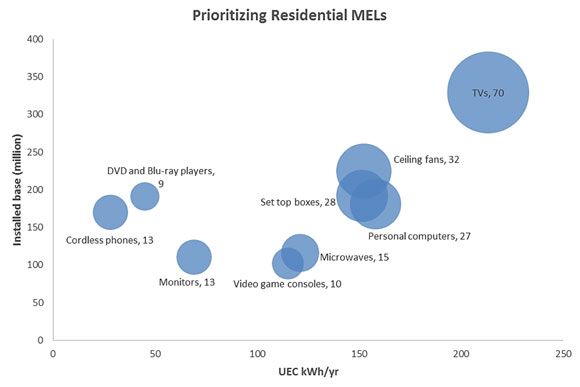By itself, the ceiling fan in your house isn’t much of an energy suck. But the number of ceiling fans in the U.S. is going up as more people move into homes in warmer climates. All of those spinning fans are adding up to nearly as much energy use as personal computers.
The ceiling fan is part of a large group of household devices and commercial equipment that make up miscellaneous energy loads in buildings. Most of the technology isn’t an energy hog by itself, but taken in aggregate, it becomes a serious opportunity for energy efficiency standards.
A new report from the American Council for an Energy-Efficient Economy (ACEEE), Miscellaneous Energy Loads in Buildings, found that all of these random devices add up to 7.8 quadrillion Btus every year, nearly as much as water heating, refrigeration and cleaning and cooking combined.
Knowing which devices are the most inefficient is particularly important as President Obama committed to increased energy efficiency in his recently unveiled climate plan. While many technologies have voluntary Energy Star standards, many have been left outside of mandatory efficiency standards that could help really make a dent in energy use.
Some items, like TVs, already have Energy Star standards but do not yet have mandatory federal standards. But ACEEE noted that the federal government still has a backlog of overdue standards and is falling behind on pending standards. ACEEE says it usually takes about three years for new standards, so Obama can’t waste any time if he wants to see the standards enacted before he leaves office.

*Size of bubble represents annual energy consumption (AEC) in TWh/year
Here are eight technologies in the home that are ripe for an energy efficiency makeover.
- Televisions. Even though your television has gotten slimmer, it is a growing part of energy use in your house. More than half of homes have at least three televisions. New TVs, such as LCD and LED models, are more efficient, but they are also usually larger, which offsets efficiency gains. ACEEE estimates that television energy use could be slashed by 89 percent if everyone in America replaced their TV with the most energy-efficient models currently available. Mandatory federal standard? DOE initiated rulemaking regarding test procedures for TVs in March 2013.
- Set-top boxes. More than 80 percent of U.S. homes have cable or satellite TV service that requires a set-top box. The energy use continues to climb with the popularity of DVRs, which require the box to be active for more times of the day. However, it could be the migration to digital content, rather than energy efficiency, that could drive down the energy requirements of the 190 million set-top boxes in the U.S. Mandatory federal standard? No current standard, but DOE began a rulemaking for test procedures in January 2013.
- Personal computers. If you ditch your cable provider to stream content on your computer, you’re not necessarily lowering your energy consumption. More efficient active and sleep modes as part of Energy Star standards have made some gains, but increasing numbers of laptops and tablets mean that many of us are more plugged in more often. The good news, however, is that the focus on increased battery life for laptops and tablets mean that cutting-edge energy-efficiency technology is already a core part of the fastest-growing segment of personal computers. Mandatory federal standard? Currently not covered.
- Video game consoles. Like personal computers, video game consoles have gotten more efficient over the years, but they have also gained in popularity and are used for a lot more than just Mario Bros. -- and many are left on all the time. If all of the video game consoles used the best available technology, energy use would be 87 percent lower. Mandatory federal standard? Currently not covered.
- Ceiling fans. Overall ceiling fan energy use is going up and is expected to increase through 2030. ACEEE estimates savings of 84 percent are possible if current fans were all replaced with the best available technology. Mandatory federal standard? There has been a federal standard since 2007, which includes variable speeds, a fan that can be controlled separately from lights and a switch to reverse the direction of fan blades. DOE initiated a revision of the standards for ceiling fans in March 2013.
- Microwaves. Even if you only use the microwave for popcorn, it can still suck up a lot of energy in standby mode. Mandatory federal standard? DOE published first energy conservation standards covering standby and off mode in May 2013. A final rule on test procedure for active mode is expected December 2014.
- Monitors. Standalone computer monitors have gotten more efficient in recent years, but usage has outstripped the gains. Since 2006, computer monitor usage has increased about 35 percent. The good news? By 2009, about 90 percent of all LCD displays smaller than 30 inches were Energy Star-qualified. Mandatory federal standard? None.
- Cordless phones, et al. If the catchall term of "miscellaneous energy loads" isn’t vague enough, try the booming area of rechargeable electronics -- including everything from cordless and cellular phones to electric toothbrushes and power tools. Unlike the VCR, the cordless phone is holding on even as cell phones proliferate. The cordless phone continues to be responsible for about half the energy consumption amongst rechargeable electronics in homes. Mandatory federal standard? Battery chargers not current covered. DOE has proposed to amend the external power supply standard to include battery chargers.



